And can you attempt to figure out her parentage?
Choices for hens: Delaware, speckled Sussex, Red/wild/brown EEs
Rooster: half red EE half Barred rock (dotted feet ((mostly yellow but with black splashes)), barred with fair amount of red leakage. dual comb)
If you know what color eggs she'll lay (both roo's sisters lay mossy green eggs), or any cool chicks she could throw into my flock I'd love to know!


Choices for hens: Delaware, speckled Sussex, Red/wild/brown EEs
Rooster: half red EE half Barred rock (dotted feet ((mostly yellow but with black splashes)), barred with fair amount of red leakage. dual comb)
If you know what color eggs she'll lay (both roo's sisters lay mossy green eggs), or any cool chicks she could throw into my flock I'd love to know!




